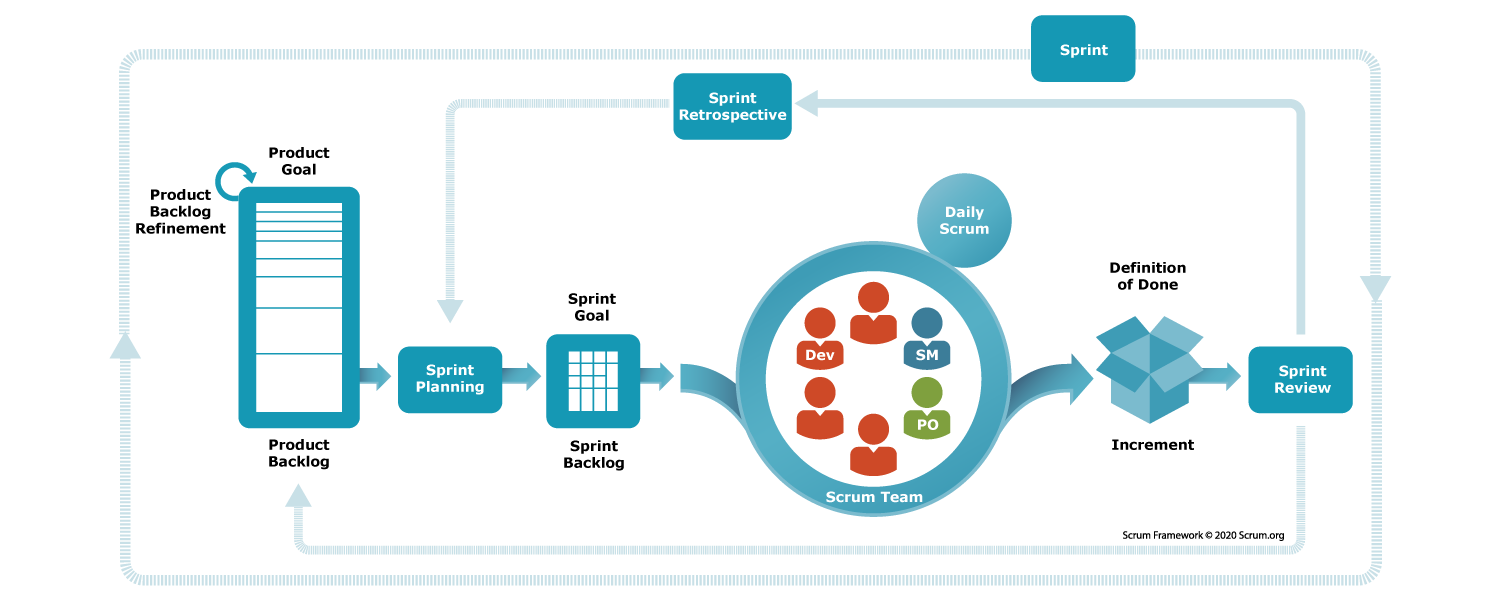Sprint Review VS Sprint Retrospective: What’s the Difference?


When talking about agility, it's hard not to refer to the Scrum framework. Often perceived as effective and simple to implement for teams willing to collaborate on incremental and iterative development, the Scrum guide (published by Ken Schwaber and Jeff Sutherland) has highlighted some key concepts to understand and put into practice in order to develop an agile mindset.
Before wearing my current Agile Coach hat, I had the opportunity to be either a Product Owner or a Team Manager (even both at the same time, but let's save that story for another time).
Among the difficulties most commonly encountered by my teams in understanding the Scrum framework, I noticed that the distinction between the Sprint Review and the Sprint Retrospective was a recurring topic.
After all, these two events follow each other and sometimes even take place on the same day. So we might be inclined to imagine that we're simply repeating the same things, with a different audience in each case.
What a mistake! Each of these two events has an important role to play.
Understanding their purpose will enable you to get the most value from a Sprint - and by extension, from your team. That's why, in this article, I'm going to tell you everything you need to know about the Sprint Review and the Sprint Retrospective. With my best tips for facilitating these two Scrum events as efficiently as possible.
In this article, we’ll cover:
What are the 5 Scrum events?
First of all, it's important to recall the theory behind the Scrum framework, as mentioned in the Scrum guide.
‘’Scrum is founded on empiricism and lean thinking. Empiricism asserts that knowledge comes from experience and making decisions based on what is observed. Lean thinking reduces waste and focuses on the essentials.’’
- Scrum Guide, 2020 edition

(source)
To support this mindset of continuous improvement, 5 events provide teams with the tools they need.
First of all, all the work required to achieve the Product goal is done within the Sprint - our first event. It's a fixed, repeated box of time (iterative).
The Sprint encapsulates the other 4 events prescribed by Scrum, detailed below.
The Sprint Planning serves as a point of departure for the team, where the Product Owner and Development team agree on a Sprint goal, the tasks deemed necessary and the plan for achieving the goal.
The Daily Scrum enables the team to have a daily exchange to inspect progress towards the Sprint goal and reduce risk.
The Sprint Review is designed to present the value delivered by the team to the stakeholders, and provides an opportunity to receive feedback from them to adjust the plan for the next Sprint.
The Sprint Retrospective gives the team the opportunity to look back on past events and learn from them for future improvement.
Now that we've had an overview of the events recommended by the Scrum Guide, let's take a closer look at the differences between these last two.
The Sprint Review: a product-oriented discussion
The Review allows the Scrum team (1 Product Owner, the development team, 1 Scrum Master) and the stakeholders to sit around the table, or on the call, depending on your physical or virtual work reality. It cultivates transparency about the value delivered during the Sprint.
As well as reiterating the objective the team committed to at the start of the Sprint, team members will be able to present their results and demonstrate the most valuable deliverables.
Thanks to this visibility, stakeholders will have a great opportunity to provide feedback and ask questions. Last but not least, these exchanges will enable the team and stakeholders to align for the next iteration.
My facilitation tips
To get the most out of the Review, the Scrum Master must ensure that the team has prepared adequately in advance. Too often, I've seen teams take for granted that the Product Owner is going to present the delivered feature, simply because they’re the point of contact for the stakeholders. Rather than organizing a one-man show, take this opportunity to split the ownership and allow each member to share their own contributions.
Screenshots, demonstrations, dashboards, pre-recorded videos - any format can be selected, as long as the information shared is clear and understandable for the audience. Remember that stakeholders are probably not as familiar with your reality and deliverables as the team is - so don’t simply share your Jira cards. The Review is the perfect opportunity for you and your work to shine. The better prepared the team is, and the more in control they are of their subject, the more confidence they will gain from stakeholders.
Ahead of the meeting, the Scrum Master should also make sure that the right people are invited to the event, especially external team members - who could share relevant feedback.
It's important that every member of the team involved has the room to exchange and communicate their points.
Success factor
At the end of the Review, all members who attended the meeting had the opportunity to discuss and agree on the next steps. Risks were exposed, and a plan was shared to contain them.
My Sprint Review agenda template
Here's the template I frequently use with the teams I coach. Without an agenda, steps 1 and 2 are often forgotten, because the team is immersed in its day-to-day, but people outside the team are not. As a facilitator, it's your responsibility to ensure a clear flow for the audience.
Introduction: to remind the objectives of the meeting.
Reminder of the Sprint objective: to clarify the context in which the team is working.
Demonstration of delivered value increment: see previous paragraphs.
Stakeholder feedback: after each presentation, a feedback period enables key elements to be identified, and encourages fluid exchange.
Evaluation of the Sprint objective: together, the collaborators evaluate whether or not the Sprint objective has been achieved.
Updating the product backlog: the feedback received enables the Product Owner to adjust the backlog in preparation for the next schedule.
Conclusion and open questions.
Now that we've demystified the Review, let's take a closer look at the last meeting of the Sprint, the Retrospective.
The Sprint Retrospective: process-oriented reflection
While the purpose of the Review is to provide visibility on the delivered value, the Retrospective provides the Scrum team with an opportunity to exchange ideas in a "by the team, for the team" format. To support a culture of continuous improvement, the team gathers to discuss and learn from the highlights of the last Sprint (but not only).
The more the team has built up mutual trust among its members, the more authentic the exchanges will be, and therefore the more valuable they will be in the future.
Please note that the team's Manager may be invited to the Retrospective if the team judges that they do not interfere with the authenticity of the exchanges.
My facilitation tips
The Scrum Master should prepare the retrospective in advance, in order to find the right approach and choose the right template to use according to the team's current context.
Has a team member just joined? Is the value delivered not deemed sufficient? Are team members feeling lost in their day-to-day work? All these scenarios require a potentially different approach.
Whether face-to-face or remote, the team will go through different states over time. Some online retrospective tools (such as Neatro) provide effective facilitation for Scrum Masters - or for any team member facilitating the meeting.
Once the retrospective has begun, the Scrum Master should encourage a healthy exchange between members. To this end, a reminder of the Prime Directive will provide a solid base for the state of mind to have when arriving at the retrospective.
“Regardless of what we discover, we understand and truly believe that everyone did the best job they could, given what they knew at the time, their skills and abilities, the resources available, and the situation at hand.”
- Norman L. Kerth, Project Retrospectives: A Handbook for Team Reviews
Success factor
At the end of the meeting, it's important to ensure that every team member has had the opportunity to express themselves freely, without judgment. The commitment of team members during the meeting is usually an excellent indicator of success.
The team usually commits to at least one action item at the end of the retrospective, giving them a concrete action to work on for the next Sprint. But be careful, creating too many action items could lead to a feeling of discouragement. That's why it's important to gauge your team members' abilities and choose your battles carefully. As a team, start with the action item you consider most strategic. Once selected, make sure you have a clear description and coherent, SMART objectives
Retrospective templates
Whether remote or face-to-face, it's essential to vary the theme of a retrospective and adapt it to the team's context. On the other hand, if you repeat the same questions at the end of each Sprint, you'll get the same answers over and over again. Not to mention the lack of commitment from team members, which will quickly catch up with you.
So here are a few templates I've used with several of my teams (all available in the Neatro experience):
For discussions around team processes: The 3 Little Pigs and Keep Drop Start
To go straight back to the last Sprint, a classic: What Went Well
To discuss the emotions of team members: Glad Sad Mad and Hot Sauces (my own creation)
To surprise team members with seasonal themes: Easter, Halloween, Christmas, and the end of the year.
For more inspiration, I suggest this list of 35 retrospective ideas.
As you can see, any excuse is a good one to vary the discussions and avoid monotony. Life's much too short to spend your last few hours of the week in a meeting where you already know the outcome, isn't it?
4 common pitfalls to avoid
Although the two events are different in both their approach and purpose, they share some common challenges. The pitfalls shared below do not constitute an exhaustive list - they are the main ones I have observed on numerous occasions through the teams I support.
1. Lack of preparation
To begin with, a lack of upstream preparation will lead to a frustrating meeting, with no real added value. A dynamic of doubt may even set in between now and the next meeting.
2. Failing to create a safe space to exchange freely
The commitment of each participant is essential. If you don't leave room for dialogue, some members may become disengaged from the meeting, and a climate of frustration may emerge.
3. Forgetting to mention successes
Not mentioning successes to stakeholders or even as a team could create a demotivating dynamic as members do their utmost to pull towards a common goal.
4. Shorten or cancel meetings
Finally, there are many excuses for shortening or canceling meetings: a team member is absent, there are cards left in the Sprint, social fatigue is setting in, etc. Unfortunately, the team would be depriving itself of a valuable source of potential learning. It will probably end up wasting the time it thought it had saved, repeating the same mistakes over and over again.
A clear understanding of the purpose and value of the Sprint Review and Sprint Retrospective promotes their adoption by team members. When conducted effectively and constructively, these two events help to build a climate of trust between your internal and external collaborators.
With the right preparation, the exchanges that emerge will be invaluable to a team in its quest for performance and continuous improvement.
Speaking of performance retrospectives! For several years now, Neatro has been making my life much easier and saving me preparation time, thanks to the templates available, which I simply select according to the context of the team I'm working with.
If you'd like to learn more, take a look at the Neatro retrospective experience. Launch a Neatro presentation demo here.
And if you'd rather take immediate action, start using Neatro for free here.



